Every winter the colors of the witch hazel flowers brighten the grounds at the Arboretum Kalmthout in Belgium.
Even when the temperatures reach -20 degrees, they keep flowering. Winter doesn’t prevent us from using these amazingly colorful flowers for macro photography, even at night.
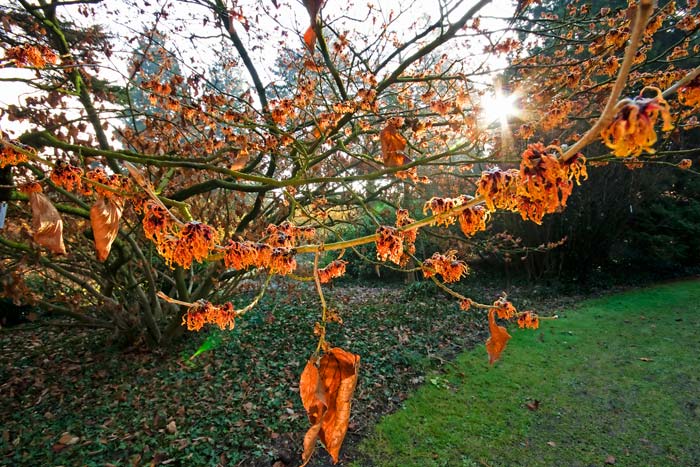
© 2011 Edwin Brosens. All rights reserved.
Hamamelis ‘Sister-jelena’ Shrub–Hybrid Which Hazel
Sony Alpha 700 + 10-20 /3.5-5.6 + Flash, f/16 @ 1/15 sec.
While other plants and trees have lost all of their color with the end of the fall season, the Witch Hazel’s journey has just begun. Witch Hazels begin blooming by the end of December and continue through mid-March. Their colors are primarily red, orange, and yellow, and their flowers and leaves contain many details.
The petals of the flowers are about 4 cm (1.5 inches) long and 3 mm wide (0.12 inches), so you you’ll need a macro lens to do them justice in a photo.
Witch Hazels perform magical tricks. At night the flowers roll up their four thin, ribbon-like petals to protect themselves through the cold night. To enhance the trick further, the flowers contain an oil (anti-freeze) that prevents them from freezing.
During your photography sessions, you’ll want to use a tripod to shoot these flowers, because during winter the force of daylight is lower. You’ll often need long exposures. And, because the pedals and leaves are so small, you’ll need to use manual focus–auto focus will have problems pinpointing your chosen point of optimum focus.
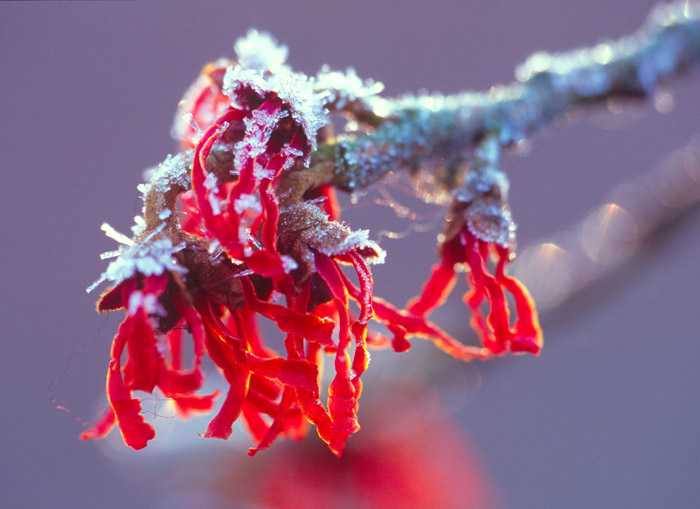
© 2011 Edwin Brosens. All rights reserved.
Hamamelis
Sony Alpha 700 + 180/3.5 APO Macro + Flash, f/13 @ 1/30 sec.
Study Your Subject
Before you begin shooting the flowers, you should spend a little time doing research of the Hamamelis. Illustrations provide the botanical flower with all its details–interesting information that is helpful for macro photography. The picture can give you a better understanding of the flower so you can let your mind travel into a visually creative fantasy, one that takes you far outside “the box.”
I asked at the Arboretum for more information about the Hamamelis and they complied, so be sure explore these possibilities for yourself.
You need to ask for help that goes beyond mere information, because you’ll also want to gain permission to have access to the botanical gardens at any time of day. Different times will open the doors to catching special photographic moments that may not coincide with the visiting hours of the gardens.
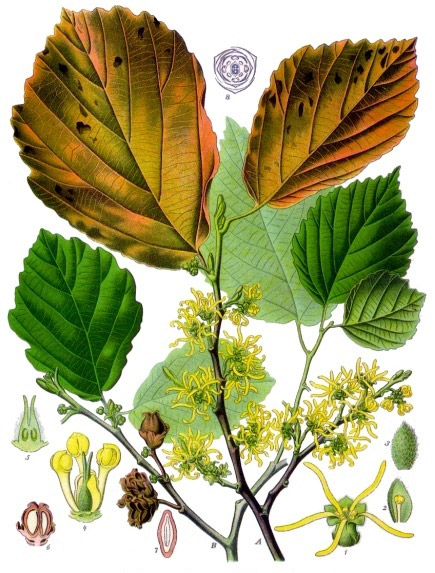
Hamamelis Illustration
This illustration is more than 100 years old and, although no one can identify the illustrator, the date can be estimated from the use of paper and paint.
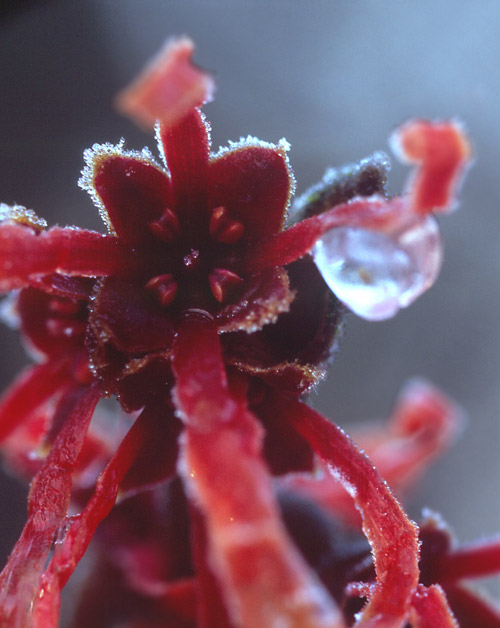
© 2011 Edwin Brosens. All rights reserved.
Hamamelis ‘Danny’–Hybrid Which Hazel
Sony Alpha 700 + 180/3.5 APO Macro + Flash,
f/11 @ 1/10 sec.
How can you find the right Hamamelis for the best composition?
After 24 years, a trunk is full grown and contains thousands of flowers. That can make it difficult to select the right flowers for your photo. As you look at a trunk, you have to look at the light that falls onto it and determine the source of light.
You get nice photos of Hamamelis by getting daylight falling from the side of the flower and less from behind yourself. You have to know from which side the source of light is strongest. If necessary, you’ll have to setup your camera from another vantage point so the shadows are better and the colors come alive.
Select a day with minimal wind. Handhold your camera and look through the viewfinder at a flower, then move the camera around the flower to see what is happening through the viewfinder. Your vision will change with this experience. Visit the same trunk a few times a week at different times of day to see how the variety in the lighting changes your shot.
Find more helpful tips on improving your flower photography
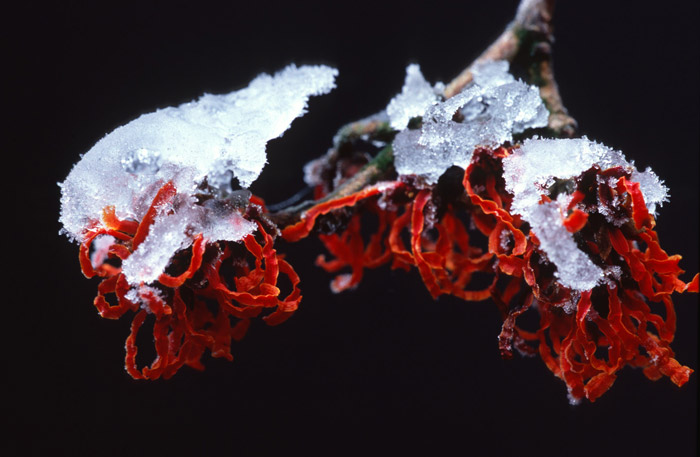
© 2011 Edwin Brosens. All rights reserved.
Ruby Glow
Sony Alpha 700 + 180/3.5 APO Macro + Flash, f/16 @ 1/60 sec.
Nights of Shooting
After a cold night of -8 degrees, ice has formed on the Hamamelis. In this unique moment, we have an opportunity to shoot great photos. Many people have no idea such winter opportunities exist. I set my camera on the tripod and searched for the composition; I used F/16 to get the leaves with the ice sharp.
And then I had to use an external flash gun in the right position and flashlight level, because the ice would reflect the harsh flash light and the contrast in the ice would detract from the effect of the image. I would recommend that you use an external flash gun at about 45 degrees from the Hamamelis and use an Omni Bounce diffuser on the flash gun.
Set the level of your manual flash at the level that is the best for each composition. To determine this, read the manual of your external flash gun–most can be set from 1/1 to 1/32. If necessary, you can use a second flash gun to get control over the shadows in the photo, but experiment with this at home before you use such a set-up on location, so you are prepared and not loosing at lot of time while shooting photos on site.
During one of my nights of shooting, the temperature, even with no wind, was -15 degrees. To shoot in the cold and during the night was no easy task. Be prepared for the cold by dressing appropriately. Wearing gloves is important, but even when they were off for short amounts of time my fingers became cold and reddened quickly.
First, I had to find the tree in the large eighteen hectare garden. The night sky may have been bright with moonlight, but I still used a lamp on my head so I could get around and set up my equipment with more ease. That was a new and fun experience. To capture the images of the flowers, I used my pocked torch, which made it possible to select a focal point.
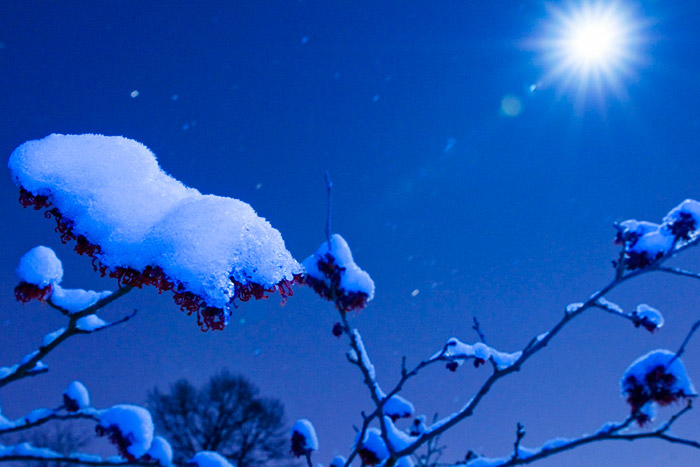
© 2011 Edwin Brosens. All rights reserved.
Moon Glow
Sony Alpha 700 + 20/1.8 + UV-Lamp, f/8 @ 180 sec.
I used a UV-lamp to light up the Hamamelis x Jelena flower. The ice reflected the blue light of the UV-lamp. The leaves of the flowers look like the pedals, though they are suppose to roll up at night to protect the stamps of the flowers–it depends on the situation of the plant if the flowers are able to roll the leaves up.
The leaves were dark orange and visible in the image because the oil in the leaves absorbed the UV-light as opposed to reflecting it like the ice did. I used a shutter speed of 10 minutes, which was a long time in such cold temperatures. I used a stopwatch to control the exposure time.
The moon became a blurred dot in the image because the long exposure time overexposed it. I set the white balance of the camera at Tungsten or 23oo Kelvin. After only one hour of work, my camera lens was filled with ice crystals.
Note: My UV-lamp has a battery that works for 1.5 hours–long enough for me to take some shots, because otherwise, at -15 degrees I could have been there for hours. The shooting experience was unique to the moment and a rare opportunity that gives other people an opportunity to see things they have never seen before.
The shooting experience was unique to the moment and a rare opportunity that gives other people an opportunity to see things they have never seen before.
Following a day of several snow storms, I visited the Arboretum once again. On this particular evening I used an old flash gun with a test button on it–Minolta 5600I. I setup my camera, using f/10 shutter speed at “Bulb” and a cable release.
Then I opened the shutter for one minute. With the external flash, I pressed the test button several times so the flash lit up the trunk. I wanted to take this opportunity to be creative without technically difficult camera settings. I encourage you to always try new techniques or you’ll never know what image possibilities there are.
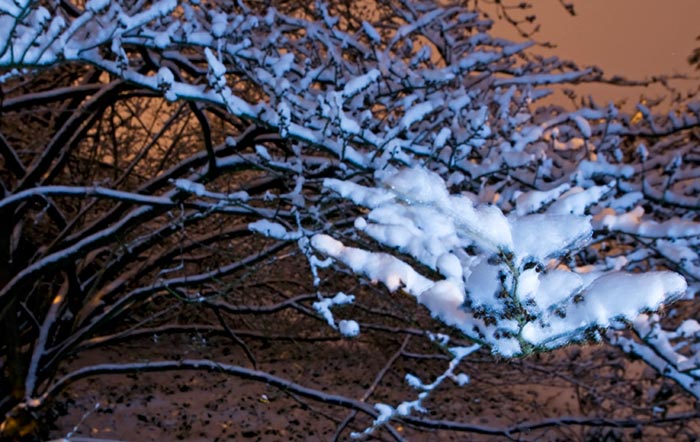
© 2011 Edwin Brosens. All rights reserved.
Sony Alpha 700 + 10-20 /3.5-5.6 + Flash, f/10 @ 60 sec.
Take It Home
I used my studio to experiment with photographing a series of shots of opening Hamamelis flowers. I looked in the arboretum and chose a twig with beautifully separated flower buds.
Note: The director of the arboretum, Abraham Rammeloo, gave me the opportunity to take home some flowers and twigs. Always ask first, explain your goals and get permission before taking any plants or flowers from any established garden.
As you’re setting up, you need to plan ahead. In order to have good compositions, you have to think about the opening flowers in the future images, so study your subject before starting.
Every twenty minutes I took a photo. The series required 12 hours to complete, because every flower opens after different time lapses. When you do this in a studio, don’t forget to sprinkle the twig with water or the twig dries up, and all your work is for nothing.
You should witness the rest of the flower opening after four hours of work, but if the twig is too dry, it stops opening, the leaves dry up and the colors disappear. Also, sometimes the shoot doesn’t go as you had hoped it would. For example, I tried shooting the series with four different flowering twigs, and I got lucky with only two of them.
Please enjoy the slideshow by clicking on the photo.
© 2011 Edwin Brosens. All rights reserved.
I hope this article inspired you to grab your photography gear and go to a local garden or arboretum near you. Or perhaps you only have to step out your door to capture great flower images in your own garden. I would be pleased to receive some of your photographs. You can send them to me at: edwin.brosens [at] gmail.com
by Edwin Brosens


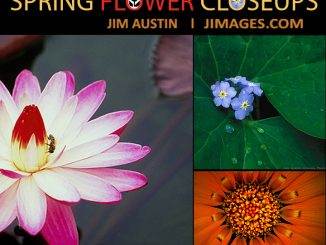
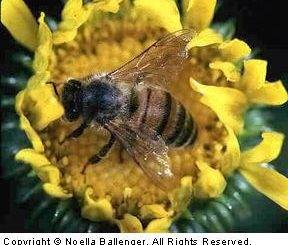
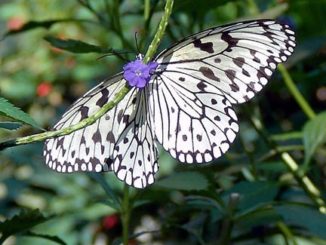
Leave a Reply